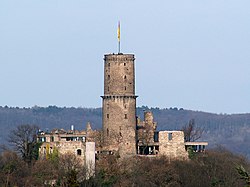Bad Godesberg
| Bad Godesberg | ||
|---|---|---|
| Stadtbezirk of Bonn | ||

Godesburg ruins
|
||
|
||
| Coordinates: 50°41′0″N 07°9′0″E / 50.68333°N 7.15000°ECoordinates: 50°41′0″N 07°9′0″E / 50.68333°N 7.15000°E | ||
| Country | Germany | |
| State | North Rhine-Westphalia | |
| Admin. region | Cologne | |
| District | Bonn urban district | |
| Town | Bonn | |
| Government | ||
| • Bezirksvorsteherin | Simone Stein-Lücke (CDU) | |
| Area | ||
| • Total | 31.97 km2 (12.34 sq mi) | |
| Elevation | 46 m (151 ft) | |
| Population (2004-01-01) | ||
| • Total | 70,525 | |
| • Density | 2,200/km2 (5,700/sq mi) | |
| Time zone | CET/CEST (UTC+1/+2) | |
| Postal codes | 53173-53179 | |
| Dialling codes | 0228 | |
| Vehicle registration | BN | |
| Website | Official Website | |
Bad Godesberg is a municipal district of Bonn, southern North Rhine-Westphalia, Germany. From 1949 till 1999 (while Bonn was the capital of West Germany), the majority of foreign embassies to Germany were located in Bad Godesberg. Some buildings are still used as embassy branch offices or consulates.
Bad Godesberg is located along the hills and cliffs of the west bank of the Rhine river, in west central Germany. Godesberg is also the name of the steep hill, of volcanic origin, on the top of which are the ruins of the Godesburg, a castle destroyed in 1583 during the Cologne War.
The following events occurred, per year:
Bonn-Bad Godesberg station is on the Left Rhine line and the line 16 and 63 of the Bonn Stadtbahn.
The town is twinned with several towns:
...
Wikipedia



